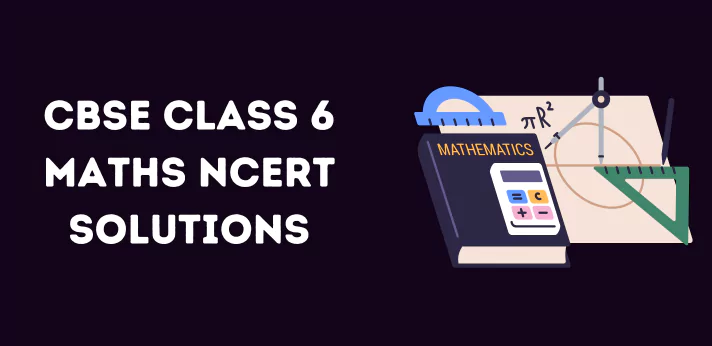Hello Students In this article, we have discussed the Class 6 Maths NCERT Solutions. NCERT Solutions are most beneficial, especially for the preparation for school as well as competitive level examinations. Classes 6 to 12 students need to have great practice of all the concepts and one of the best ways to achieve the same is through NCERT Solution.
This article has cleared up all the detailed solutions to NCERT textbooks’ questions in PDF format. You can download Maths NCERT Solutions for Class 6 in PDF format, which is Free.
[Index]
Overview
Before we discussed the CBSE Class 6 Maths NCERT Solutions. Let us check the Class 6 Maths Summary. below we have mentioned the complete Class 6 Maths Summary. students are advised to check out the complete summary.
| Particulars | Description |
| Class | 6th |
| Board | CBSE |
| Subject | Maths |
| Category | NCERT Solutions |
| Study Materials | Click Here |
| Class 6 Free E-Book | Click Here |
| Youtube Channel | Subscribe now |
Class 6 Maths NCERT Solutions
Below we have mentioned the Maths NCERT Solutions for Class 6. Students have checked the complete Class 6 Maths NCERT solutions in pdf for a great score in the final examination.
| S.No. | Class 6 Mathematics NCERT Solutions |
| 1 | Class 6 Maths NCERT Solutions |
CBSE Class 6 Maths Syllabus 2024-25
Understanding the Maths, Mathematical questions and other mathematical operations is a concern for Class 6 Mathematics. Let us now discuss the CBSE Class 6 Maths syllabus with topics to be covered and the month assigned.
| Chapter Name | Topic to be Covered |
| Chapter 1: Knowing Our Numbers | 1.1 Introduction 1.2 Comparing Numbers 1.3 Large Numbers in Practice 1.4 Using Brackets 1.5 Roman Numerals |
| Chapter 2: Whole Numbers | 2.1 Introduction 2.2 Whole Numbers 2.3 The Number Line 2.4 Properties Of Whole Numbers 2.5 Patterns in Whole Numbers |
| Chapter 3: Playing With Numbers | 3.1 Introduction 3.2 Factors and Multiples 3.3 Prime and Composite Numbers 3.4 Test For Divisibility Of Numbers 3.5 Common Factors and Common Multiples 3.6 Some More Divisibility Rules 3.7 Prime Factorisation 3.8 Highest Common Factor 3.9 Lowest Common Multiple 3.10 Some Problems on HCF and LCM |
| Chapter 4: Basic Geometrical Ideas | 4.1 Introduction 4.2 Points 4.3 A Line Segment 4.4 Aline 4.5 Intersecting Lines 4.6 Parallel Lines 4.7 Ray 4.8 Curves 4.9 Polygons 4.10 Angles 4.11 Triangles 4.12 Quadrilaterals 4.13 Circles |
| Chapter 5: Understanding Elementary Shapes | 5.1 Introduction 5.2 Measuring Line Segments 5.3 Angles-’Right’ and ‘Straight’ 5.4 Angles- ‘Acute’, ‘Obtuse’ and ‘Reflex’ 5.5 Measuring Angles 5.6 Perpendicular Lines 5.7 Classification of Triangles 5.8 Quadrilaterals 5.9 Polygons 5.10 Three Dimensional Shapes |
| Chapter 6: Integers | 6.1 Introduction 6.2 Integers 6.3 Addition of Integers 6.4 Subtraction of Integers with the help of a Number Line |
| Chapter 7: Fractions | 7.1 Introduction 7.2 A Fraction 7.3 Fraction on the Number Line 7.4 Proper Fractions 7.5 Improper and Mixed Fractions 7.6 Equivalent Fractions 7.7 Simplest Form of a Fraction 7.8 Like Fractions 7.9 Comparing Fractions 7.10 Addition and Subtraction of Fractions |
| Chapter 8: Decimals | 8.1 Introduction 8.2 Tenths 8.3 Hundredths 8.4 Comparing Decimals 8.5 Using Decimals 8.6 Addition of Numbers with Decimals 8.7 Subtraction of Decimals |
| Chapter 9: Data Handling | 9.1 Introduction 9.2 Recording Data 9.3 Organisation of Data 9.4 Pictograph 9.5 Interpretation of a Pictograph 9.6 Drawing a Pictograph 9.7 A Bar Graph |
| Chapter 10: Mensuration | 10.1 Introduction 10.2 Perimeter 10.3 Area |
| Chapter 11: Algebra | 11.1 Introduction 11.2 Matchstick Patterns 11.3 The Idea Of A Variable 11.4 More Matchstick Patterns 11.5 More Examples of Variables 11.6 Use Of Variables in Common Rules 11.7 Expressions with Variables 11.8 Using Expressions Practically 11.9 What is an Equation? 11.10 Solution of an Equation |
| Chapter 12: Ratio and Proportion | 12.1 Introduction 12.2 Ratio 12.3 Proportion 12.4 Unitary Method |
| Chapter 13: Symmetry | 13.1 Introduction 13.2 Making Symmetric Figures: Ink-blot Devils 13.3 Figures With Two Lines of Symmetry 13.4 Figures with Multiple Lines of Symmetry 13.5 Reflection and Symmetry |
| Chapter 14: Practical Geometry | 14.1 Introduction 14.2 The Circle 14.3 A Line Segment 14.4 Perpendiculars 14.5 Angles |
Class 6 Study Material
We have tried to bring CBSE Class 6 NCERT Study Materials like Syllabus, Worksheet, Sample Paper, NCERT Solutions, Important Books, Holiday Homework, Previous Year Question Papers etc. You can visit all these important topics by clicking the links given.
Frequently Asked Questions (FAQ)
How Do I Study With the Class 6th Maths Syllabus?
The Class 6 Maths Syllabus can plot an ideal study plan, so the students are always ready for their final exams and score good marks to remain ahead within the class. The students are advised to travel through the syllabus before beginning with their studies, so they plan the topics that are coming within the exams. They’ll also categorize the identical into easy, moderate, and difficult as per their mentality.
What is the syllabus of Class 6 Maths?
The CBSE Syllabus For Class 6 Maths is based on one book.
What are the books for Grade 1?
According to the Class 6 Syllabus, the NCERT Books for class 6 are – Maths.
Where will we get the free class 6 study material?
We are Edufever are Free and Open portal for all students to study with study material; we provide the free study material for all classes like syllabus, ebooks, worksheets, videos, sample papers, practice papers, NCERT Books etc.
